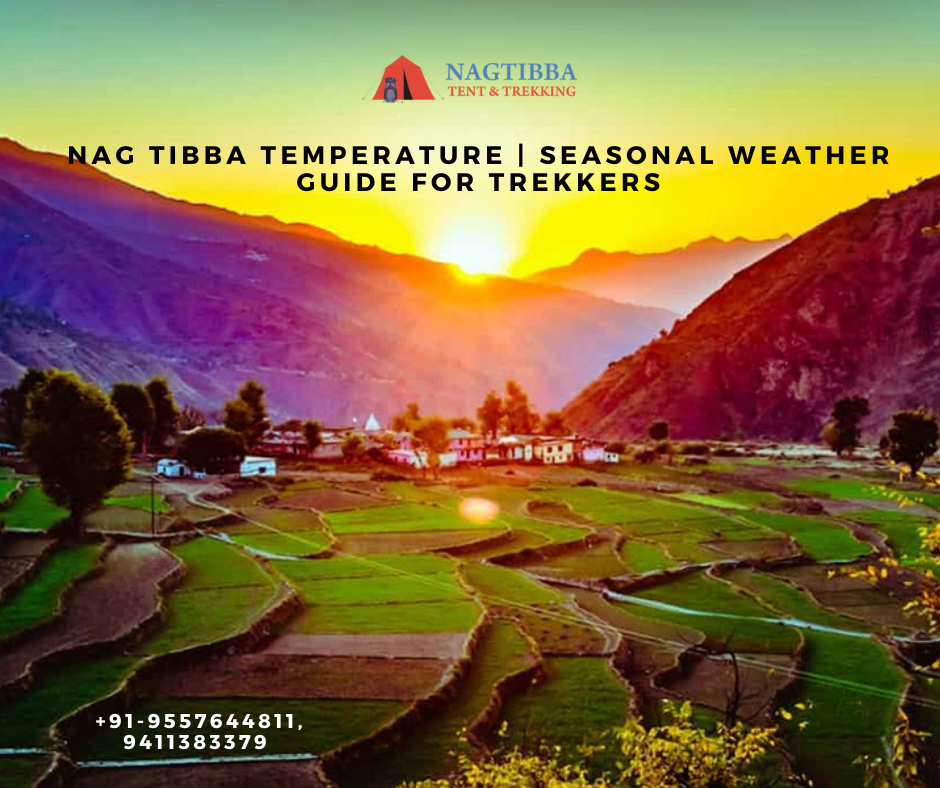Nag Tibba, one of Uttarakhand’s most sought-after trekking destinations, offers stunning views of the Himalayas and an enriching adventure through diverse landscapes. Understanding the temperature variations across seasons is crucial for planning a safe and enjoyable trek. Whether you’re seeking snow-covered trails or pleasant springtime weather, this guide covers everything you need to know about Nag Tibba‘s seasonal temperatures.
Overview: Nag Tibba Weather Guide 2025
| Season | Temperature Range | Highlights |
| Winter (Dec-Feb) | -5°C to 10°C | Snowy trails, clear skies, freezing nights |
| Spring (Mar-Apr) | 5°C to 15°C | Blooming flora, mild days, chilly nights |
| Summer (May-Jun) | 10°C to 25°C | Warm days, cool evenings, clear views |
| Monsoon (Jul-Sep) | 15°C to 20°C | Lush greenery, slippery trails, occasional rains |
| Autumn (Oct-Nov) | 5°C to 15°C | Crisp air, vibrant foliage, ideal trekking conditions |
Nag Tibba Temperature by Season
Winter (December to February 2025)
- Temperature Range: -5°C to 10°C
- Highlights: The trail transforms into a winter wonderland, with thick snow blankets covering the path and summit. Days are crisp and sunny, while nights can drop to sub-zero temperatures. Prepare for icy winds at higher altitudes.
- Tips: Carry multiple warm layers, insulated sleeping bags, and sturdy trekking boots for snow.
Also Check: Nag Tibba Trek 2025 | Best Weekend Trek in January
Spring (March to April 2025)
- Temperature Range: 5°C to 15°C
- Highlights: Spring brings vibrant blooms and lush greenery to the trail. The moderate temperature makes it an excellent season for trekking.
- Tips: Pack light layers for daytime trekking and a warm jacket for the evenings.
Summer (May to June 2025)
- Temperature Range: 10°C to 25°C
- Highlights: The warm days and cool nights create comfortable trekking conditions. Clear skies provide uninterrupted views of Himalayan peaks like Bandarpoonch and Swargarohini.
- Tips: Wear breathable clothing and stay hydrated to beat the heat during daytime hikes.
Also Check: Snow Winter Trek: Nag Tibba Itinerary 2025
Monsoon (July to September 2025)
- Temperature Range: 15°C to 20°C
- Highlights: The monsoon season revitalizes the region with lush greenery, but trails can be slippery and prone to landslides. Trekking during this season is less common but offers a serene, rain-washed experience.
- Tips: Pack waterproof gear, quick-dry clothing, and sturdy trekking poles.
Autumn (October to November 2025)
- Temperature Range: 5°C to 15°C
- Highlights: Autumn offers the perfect balance of pleasant temperatures and stunning views. Vibrant foliage and clear skies make it a favorite among trekkers.
- Tips: Bring light layers for daytime and heavier layers for colder evenings.
Also Check: Nag Tibba in Snow: A Beginner-Friendly Winter Trek Guide
How Temperature Impacts Trekking Conditions
- Trail Accessibility: Snow in winter and rain in monsoon can make trails challenging. Summers and autumn are ideal for smoother trekking experiences.
- Packing Essentials: Temperature variations demand careful packing, from insulated clothing in winter to breathable layers in summer.
- Camping Comfort: Winter nights can be freezing, requiring high-quality sleeping gear, while summers offer more comfortable camping conditions.
Packing Essentials for Nag Tibba Trek
Seasonal Gear Checklist
- Winter: Down jacket, thermal layers, snow boots, and gloves.
- Spring/Autumn: Light trekking gear, warm jackets for the evening, and sturdy footwear.
- Summer: Breathable fabrics, sunglasses, sunscreen, and hydration packs.
- Monsoon: Waterproof clothing, rain covers, and anti-slip boots.
Also Check: Nag Tibba Trek 2025: A Comprehensive Guide to Uttarakhand’s Winter Wonder
Best Time to Visit Based on Temperature
- For snow lovers, December to February is the best time.
- To experience blooming landscapes, visit in spring (March-April).
- For clear views and mild weather, summer (May-June) and autumn (October-November) are ideal.
Plan your trek with confidence and experience the unique charm of Nag Tibba across seasons. Whether you seek the thrill of snow or the serenity of summer, Nag Tibba promises an unforgettable Himalayan adventure!
FAQs About Nag Tibba Temperature
Q: Can I trek Nag Tibba in sub-zero temperatures?
A: Yes, but proper winter gear and preparation are essential for a safe trek.
Q: Does it snow on Nag Tibba?
A: Yes, heavy snowfall is common during December to February.
Q: What is the most comfortable season for first-time trekkers?
A: Autumn (October-November) and spring (March-April) offer the most comfortable temperatures for beginners.

